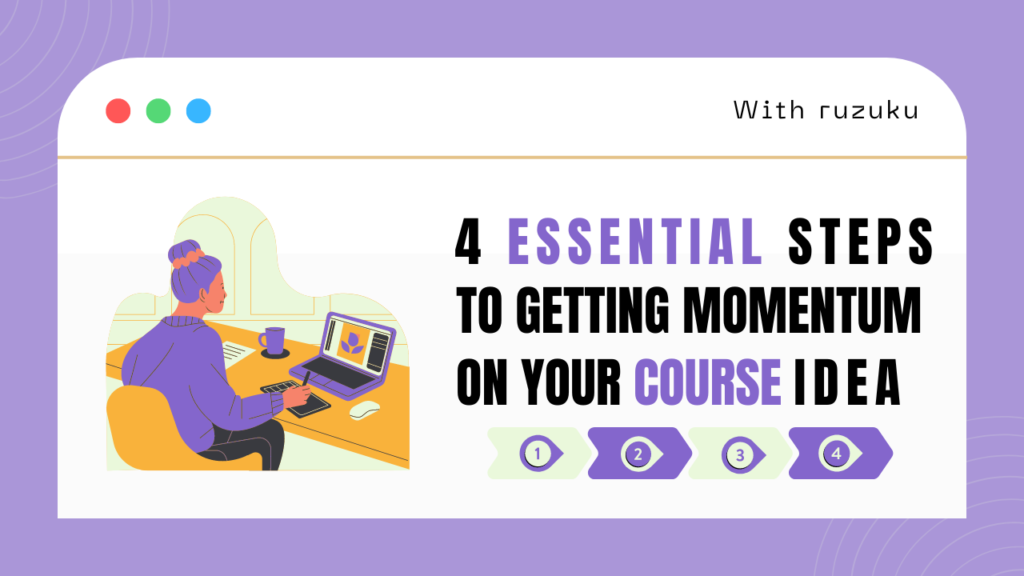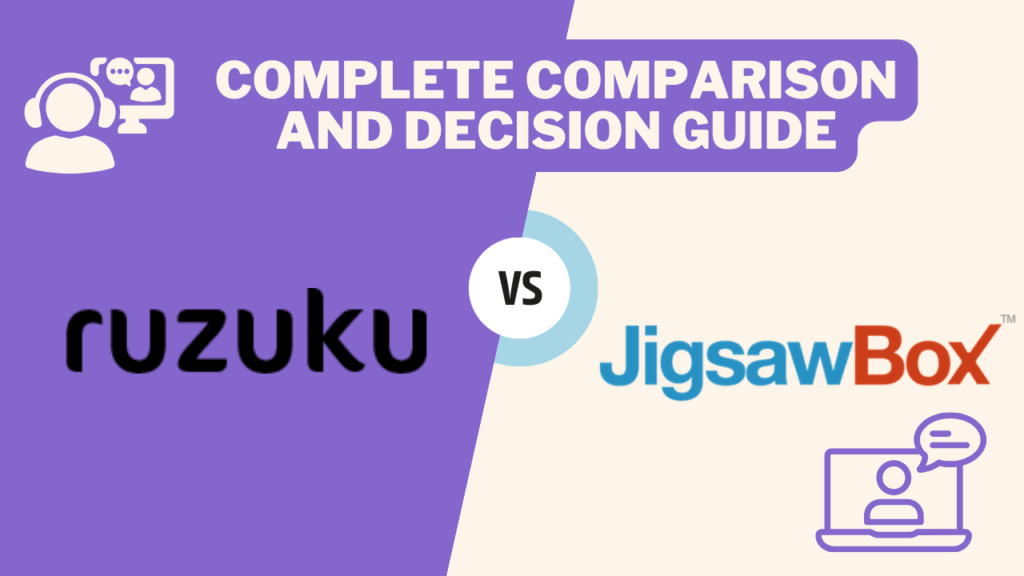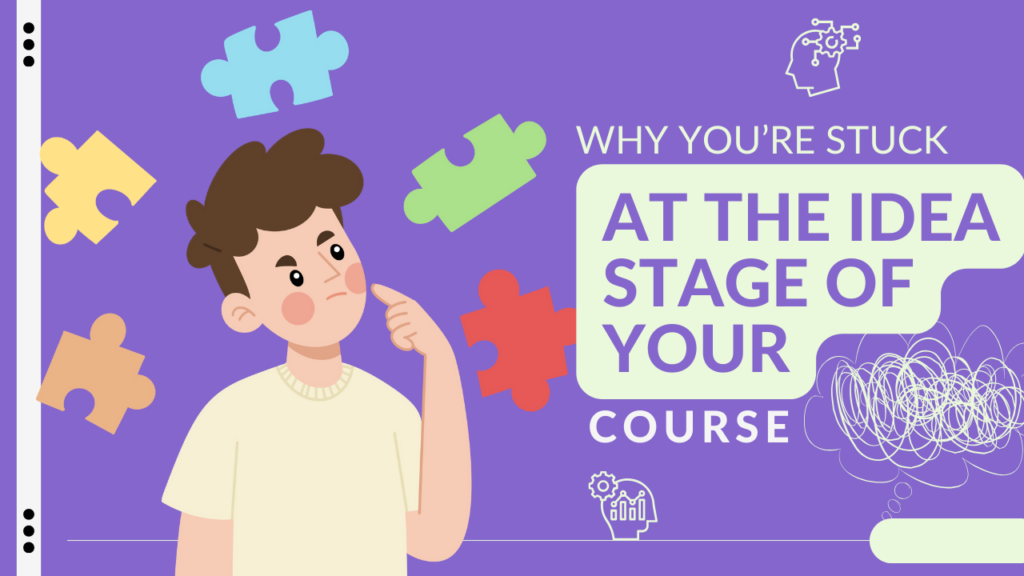Do you ever feel like your big course idea is never going to make it out of your head?
Like it might sit there collecting dust — until someone else has the same idea and creates a brilliant course that brings them the income and students that could have been yours?
That’s part of why Ruzuku runs our twice-yearly 30 Day Course Creation Challenge. It’s designed to help you get over anything that stands in the way of getting your course out into the world.
But does the Challenge really work?
There are plenty of successful instructors who have crossed the Challenge finish line, but we didn’t want to take their word for it.
Instead, two members of the Ruzuku team decided to put on their participant hats and take the Challenge for a test drive.
Here’s what happened.
Introducing… the challengers
Jessica
I’m the Blog Editor and Content Writer for Ruzuku. I’m also a yoga teacher who helps social entrepreneurs find and maintain a work-life balance that works for them.
I’ve crossed the line into burnout several times through my career — I found my way back a little stronger every time, and that experience motivated me to help others who are struggling to create a sustainable life and career.
Course creator type: Teacher
This came as no surprise — most of my work has involved teaching in some form. It’s the majority of what I do in my business outside of Ruzuku, and my intention is to add online courses to the mix of in-person teaching I already do.
Business stage: Starter
I started the business almost 3 years ago, and since then it’s been very slowly building as I have time to dedicate to it. I have a small mailing list and no employees.
Stage of course creation: Acceleration
Even though my business has been slowly building, I’ve worked in the online marketing and course creation field for the past 2 years. The knowledge that I’ve gained set me up to move quickly and to get as far as I could during the Challenge.
Since the business itself is still small, the focus of the course I wanted to create during the Challenge would help more people discover my work, and bring new clients in the door — focusing on the discovery phase of the customer journey.
Lisa
I’m the affiliate manager for Ruzuku. I also work with other clients doing affiliate promotions and influencer marketing.
Basically, I know a guy. It’s my job to know people, to meet people, to get to know new people, and to introduce awesome people to each other. I’m really good at this, and I designed my business of influencer marketing around my strength of knowing people and connecting people.
Course creator type: Coach
I think that’s accurate to an extent — I’ve always loved coaching people and helping them succeed. I have a background in adventure facilitation, which involves a lot of coaching others to discover and grow. But it’s not at all what I’m doing with my business right now. I solve problems and do projects directly for clients.
Business stage: Starter
Although I’ve been doing this type of work for a couple of years, I officially started my business about a year ago, and I don’t have any employees.
Stage of course creation: Exploration
I’ve never taught this before, so I’m just exploring the idea of adding teaching to my business.
My focus for the Challenge was to validate my course idea — more specifically, that it’s a course that I would enjoy teaching.
Felicity
For those of you who don’t know Felicity, she’s the Customer Success Specialist extraordinaire at Ruzuku. She was our behind-the-scenes support during the Challenge, asking the tough questions and helping us all make our course journey the best it could possibly be.
While Abe ran the live calls and oversaw the Challenge as a whole, Felicity was down in the trenches with the Challenge participants during (and after) the 30 days, guiding us step by step.
Where did your ideas come from?
Every course starts with an idea (or more than one in some cases). We both came into the Challenge with course ideas we wanted to explore.
Jessica
When I started the Challenge, there were two possible directions for my course creation.
I’m getting ready to teach a 6-week in-person class series in the spring that will be a look into the life of a sustainable changemaker. It’s an exploration of how to stay healthy and balanced while doing it all — work, life, and saving the world.
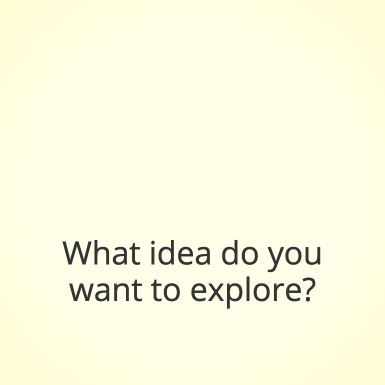 For the purpose of the Challenge, Felicity helped me figure out that it made more sense to follow along with the Starter business focus of creating a mini-course to help more people discover my work.
For the purpose of the Challenge, Felicity helped me figure out that it made more sense to follow along with the Starter business focus of creating a mini-course to help more people discover my work.
The course idea itself came out of the audience research that I’ve gathered over the life of my business.
I see so many social entrepreneurs who are overwhelmed by stress, and who deal with so many distractions that they can’t break free of FOMO (fear of missing out). They simply sit and spin their wheels, never actually moving forward.
Since it’s an issue I’ve worked hard to overcome in my own life, it seemed like the perfect place to start for my intro course. (It also happens to be the subject of the first module of my 6-week in-person class. Bonus!)
Lisa
The story behind my idea is pretty simple! I kind of stumbled into the field of affiliate and influencer marketing. I’ve always been really good at meeting new people and connecting people to each other, so when I discovered this could be a job I jumped at the chance.
I’ve worked with several clients whose products were online courses, so I’ve gotten a backstage view of how successful online courses can be as a foundation for a business. I’ve thought for a while that I should try to do something with an online course someday.
I had a lot of ideas — in fact, I wear a custom necklace I had made that says “I have an idea,” because I literally have a new business idea every week (at least). Sticking with ideas is always a problem for me.
My ideas usually have to do with something that I’m not very good at — I think of business ideas that solve problems I have. Those won’t work for a teaching business, because you need to teach something you do know.
This idea was born when I heard someone say that if you want to teach, you should teach the thing that you’re really good at but other people aren’t.
Ask yourself the question, what comes really easily to you that other people struggle with? That thing that you do as easily as breathing — that’s what you should teach.
And when I heard that, I immediately knew the thing that was easy as breathing for me and hard for a lot of people: talking to strangers.
Where did you want to be at the end of the Challenge?
One of the very first things that Abe asked on the kickoff call was “what does success look like?”
He had all of the Challenge participants write down where they wanted to be by the end of the 30 days. A big focus was on setting an achievable goal and creating a game that we could win — setting ourselves up for success.
Jessica
It’s been a while since I originally made the decision to incorporate some kind of online course into my business model. But to this point it was always just something I would do someday.
The Challenge gave me the chance to dive in head first and see how far I could get toward that goal in the 30 days.
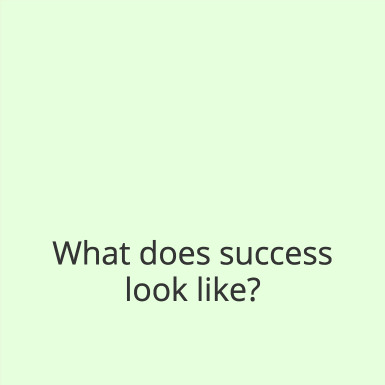 I have a “bribe to subscribe” on my landing page, but I’ve been meaning to create an additional opt-in bribe for a while now — so the intro course fits perfectly.
I have a “bribe to subscribe” on my landing page, but I’ve been meaning to create an additional opt-in bribe for a while now — so the intro course fits perfectly.
For me, success meant having at least a rough draft of my email course written out by the end of the 30 days, and some beta testers to help me improve it.
Lisa
I wanted to be part of the Challenge just for the experience of it.
I don’t have any goal of launching a course anytime soon, and I’m not even sure if this is the course I want to launch (all those ideas, remember?). I’ve never taught this subject, so I don’t really know how I would teach it.
My goal was simply to play with the idea. I wanted to actually put something down on paper, to make good progress toward course creation, and to figure out whether this is something I would enjoy.
What surprised you about your experience?
Now that the introductions are over, let’s get into the Challenge itself.
It’s very different watching something take place from an observer’s perspective than it is from actually participating. During the Challenge, we both learned some surprising things — both about our course material, and about ourselves.
Week 1:
The big goals for week one were to get clear on who we’re serving and identify one key result that participants will get from our course.
Jessica
Before the Challenge had even officially started I had my first moment of panic, thinking “why in the world am I doing this to myself?”
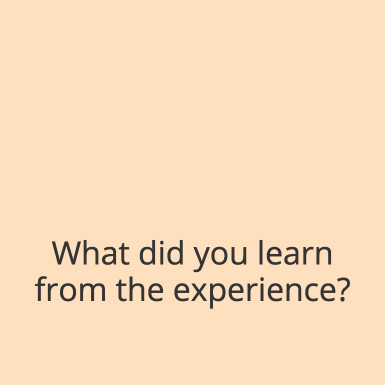 I could have stayed in the shadows, watching from behind the scenes — but I had already agreed to do the Challenge and write up my experience for this case study, so I was publicly committed. There was no going back!
I could have stayed in the shadows, watching from behind the scenes — but I had already agreed to do the Challenge and write up my experience for this case study, so I was publicly committed. There was no going back!
Felicity helped me get really specific about who I’m working with.
She also helped me take a rather large list of potential problem language and narrow it down to a list of three: distractions, time management, and FOMO.
The solution my course provides is to “help social entrepreneurs overcome FOMO and ‘entrepreneurial ADD’. My course will help them set clear priorities and eliminate the busy work that doesn’t move their world-changing project forward, giving them more time to focus on the things that really matter.”
I struggled with with coming up with a title for the course. In fact, I got stuck on that lesson for the rest of the week. I still haven’t figured out a great title, but I decided that I wasn’t going to let that stop me in my tracks!
Lisa
I loved this Challenge, because the homework was always really simple.
The biggest challenge for me was just finding the time to do the work. Most of the time, I wasn’t able to make time every day, but I could sit down on Friday and go through the work for the week in a couple of hours.
Week 2:
The activities for week two included crafting an elevator pitch for the course, deciding whether our course would be free or paid, and connecting with potential participants.
That’s right — we had to get people to “raise their hands” before our course content was even finished. Talk about nerve-wracking!
Jessica
Like Lisa, after I got stuck on the title for my course and fell behind, I tended to push off the course material until the end of each week.
As Ruzuku Blog Editor I was trying to balance the Challenge with our publication deadlines for the blog — and the blog won, every single time.
The elevator pitch was fun to write, and the decision between free and paid was already made for me. Since I’m using the course as an intro to my work, it will be free (in exchange for an email address).
I did a combination of outreach — to my personal network, an email to my mailing list, and a post on my personal FB page.
I have lots of connections with people who fall into my target audience, so finding a handful of beta testers wasn’t an issue. I found my first 5 people within a couple of hours of reaching out to two group of colleagues.
The most surprising thing was the email that I sent out to my list — the email had a 44% open rate, and absolutely no responses. During the final week of the Challenge I put up a post to my Facebook page and got 3 more people to raise their hands, for a total of 8 beta testers.
It was surprisingly difficult to get over my fear of asking for people to help out. I ran into a lot of resistance, and it took me a couple of weeks to get up the courage to reach out to both my email list and folks on Facebook. Not getting any response from the email list made reaching out again even more difficult.
I knew that having a broader group of people to test would be beneficial, but taking action was harder than I would have thought!
Lisa
The first couple of weeks were easy for me, since marketing is my job. Writing target customer profiles, benefits and goals, and elevator pitches is old hat for me. So I was able to get through those really easily.
I was a bit nervous though — I felt like if we were spending two weeks on groundwork, I couldn’t imagine how much of the actual course I would get done in the month.
Week 3:
Week three is where the course content comes into play. Our tasks were to outline the course and begin to create minimal content that would help participants move toward the #1 outcome of our courses.
Jessica
Time for complete transparency. I got to the beginning of week three… and completely freaked out.
I spent the entire week doing more research, and didn’t even read Monday’s lesson until the end of the week. I just saw “create a course outline” in the lesson title and spun out.
But as Felicity reminded me, I don’t need to solve all the problems right now. She had me focus on just this one, with the goal of helping my participants set the right habits that will lead them into my next paid course.
After I finally managed to get my course outline done, I was like “now I have to write one of the lessons?!” and didn’t do anything else until after the Challenge was over.
In fact, it wasn’t until Wednesday of last week (with 6 days until my publication deadline) that I started working on the Challenge lessons again…
Lisa
The outline turned out to be a lot easier than I anticipated.
One of the biggest things that helped me in this course was the simplicity of the Challenge course itself. I’ve worked with clients who sell really in-depth courses for thousands of dollars, so when I think “online course,” I think of something really extensive and complex.
But the Challenge was so simple, it made me realize that my course could be simple, too.
And I enjoyed going through the Challenge so much more than those lengthy, detailed courses I’ve taken. It didn’t require a tremendous time commitment or an overwhelming amount of work.
There were a lot of days when I sat down thinking I would never be able to catch up – I was behind pretty much the entire month! – but even if I had a weeks’ worth of lessons to get through, I was never overwhelmed once I actually started working.
Week 4:
During the final week of the Challenge, our tasks included creating welcome and conclusion activities and planning out the course timeline.
Jessica
Interestingly enough, once I quit freaking out and just wrote that first lesson I started making progress again.
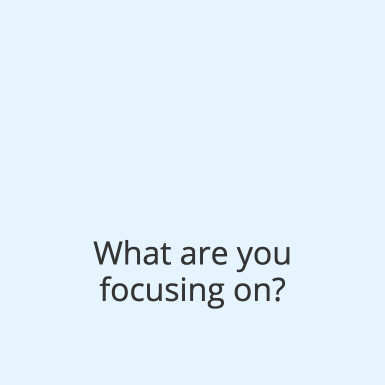 After I wrote up the lesson, it was simple to continue with the introduction and conclusion lessons — and then the other two lessons in the first module.
After I wrote up the lesson, it was simple to continue with the introduction and conclusion lessons — and then the other two lessons in the first module.
So to recap: I got stuck on the first lesson of week 3… for over 2 weeks. And then finished up the last 2 weeks of Challenge material in 2 evenings.
I squared away the delivery schedule that I want to test out for the 11 emails, and have my plan for getting feedback from my beta testers. And I set some clear next steps and a timeline to have the course beta tested and up and running by the first of the year.
Lisa
Week 4 was the biggest challenge, and to be honest, I haven’t truly finished that week’s content.
I haven’t planned a launch date, and I may never launch the course. I had a lot of hesitations come up as I faced the reality of actually trying to make something live.
The thing is, I’ve taken several courses on this topic of connecting with people, and I’m not sure that I have anything useful or new to add to what’s already out there. I know this is a common problem, this fear of not having anything to say. But since this is something I’ve never taught, it may be true — I might not have anything valuable to say in this space.
Looking back, what did you learn from your experience?
At the end of the Challenge, we took a look back at the experience as a whole — lessons learned, ways the experience helped us move forward, and the overall impact of participating.
Jessica
While there was never any real danger of me not finishing the course – with an unmoving publishing deadline and everything that was holding me accountable – it was actually a little bit touch and go toward the end.
It still scares me that I don’t have all of my content done. But in staying true to the Challenge, I’ll start co-creating the rest of the content when I work with my beta testers.
I have the intro email, the complete first module, and the conclusion drafted up so that should be enough to start working with them in the next couple of weeks.
I was surprised how much resistance I encountered as I was working through the Challenge.
There’s a lot of the psychology that we help people overcome with our blog content, and yet here I was running into the same issues and face-planting into the same challenges that our readers encounter as they create their online courses.
Even with a couple of years of experience and knowledge backing me up, this was a humbling experience, and it gives me that much more respect for those folks who have gotten their online courses up and running. You’re all amazing!
The biggest way that the Challenge helped me to move forward with my course was by forcing me to finally take action instead of continuing to muddle the idea around in my head. The two things that helped the most were: 1) being publicly accountable for finishing the Challenge, and 2) having Felicity’s help and support along the way.
Lisa
I still don’t know for sure if I’m going to launch this course. However, I think the Challenge was very valuable for me.
For one thing, it gave me a really great step-by-step process to move toward doing something I’ve been thinking about doing for a long time. And that felt good.
 I will probably want to go back and revise everything I’ve done before I think about sharing anything publicly, but knowing that I can do this – that even in 30 days I can come up with a solid outline for this topic – did show me that I have something to say about it.
I will probably want to go back and revise everything I’ve done before I think about sharing anything publicly, but knowing that I can do this – that even in 30 days I can come up with a solid outline for this topic – did show me that I have something to say about it.
Second, the recognition that a course can be really simple and still be valuable was a really big deal for me. I’ve only seen courses that were really involved and detailed.
The simplicity of the Challenge made it so easy to be part of, and it also made me feel like creating an online course is an achievable goal for me.
I can see a lot of value in just giving people step-by-step guidelines — helping with a structure to move people forward. An online course can be as simple as that.
So the Challenge was a good exploration for me.
I’m definitely going to work with these ideas more. I’m going to look back at the similar courses I’ve taken and see if I can identify what my USP is — what would make my course unique.
Even if I don’t move forward with this exact idea, I am definitely going to use the Challenge guidelines for future ideas.
Stop thinking and start doing
You’ve read our stories.
Now it’s time to look at your course idea.
You have an idea. You know you want to do something with it. And now you’ve seen the inside scoop on how much you can accomplish in a short period of time with the right support and motivation.
We’ve shown you our path through the 30 Day Course Creation Challenge. Now it’s time for you to get to work.
Because seeing your course idea come to life is so much better than just dreaming!
How will you finally move forward and get your course idea out of your head and into the world? And how can the team at Ruzuku help you get your idea out into the world?


